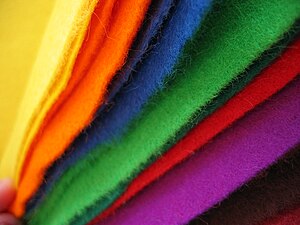| The requirements to this merit badge are copyrighted by the Boy Scouts of America. They are reproduced in part here under fair use as a resource for Scouts and Scouters to use in the earning and teaching of merit badges. The requirements published by the Boy Scouts of America should always be used over the list here. If in doubt about the accuracy of a requirement, consult your Merit Badge Counselor. |
|---|
| Reading this page does not satisfy any requirement for any merit badge. Per National regulations, the only person who may sign off on requirements is a Merit Badge Counselor, duly registered and authorized by the local Council. To obtain a list of registered Merit Badge Counselors, or to begin a Merit Badge, please contact your Scoutmaster or Council Service Center. |

Requirement 1
editDiscuss with your merit badge counselor the importance of textiles. In your discussion define the terms fiber, fabric and textile. Give examples of textiles you use every day.
Requirement 2
editDo the following:
- A. Get swatches of two natural fiber fabrics (100 percent cotton, linen, wool or silk; no blends) Get swatches of two synthetic fiber fabrics (nylon, polyester, acrylic, olefin, or spandex). Get a sample of one cellulosic fabric (rayon, acetate or lyocell).
- B. Give the origin, major characteristics, and general content of each type of fiber obtained for 2(a). Explain the difference between a cellulosic manufactured fiber and a synthetic manufactured fiber.
- C. Describe the main steps in making raw fiber into yarn, and yarn into fabric.
- D. Assume you will soon buy a new garment or other textile item. Tell your counselor what fiber or blend of fibers you want the item to be, and give reasons for your choice.
Requirement 3
editDo TWO of the following:
- A. Visit a textile plant, textile products manufacturer or textile school or college. Report on what you saw and learned.
- B. Weave a belt, headband, place mat or wall hanging. Use a simple loom that you have made yourself.
- C. With a magnifying glass, examine a woven fabric, a nonwoven fabric, and a knitted fabric. Sketch what you see. Explain how the three constructions are different.
- D. Make a piece of felt.
- E. Make two natural dyes and use them to dye a garment or a piece of fabric.
- F. Waterproof a fabric.
- G. Demonstrate how to identify fibers, using a microscope identification or the breaking test.
Requirement 4
editExplain the meaning of 10 of the following terms: warp, harness, heddle, shed, aramid, [[w:Spandex|spandex], sliver, yarn, spindle, distaff, loom, cellulose, sericulture, extrusion, carbon fibers, spinneret, staple, worsted, nonwoven, greige goods.
Requirement 5
editList the advantages and disadvantages of natural plant fibers, natural animal fibers, cellulosic manufactured fibers, and synthetic manufactured fibers. Identify and discuss at least four ecological concerns regarding the production and care of textiles.
Requirement 6
editExplain to your merit badge counselor, either verbally or in a written report, five career possibilities in the textile industry. Tell about two positions that interest you the most and the education, cost of training and specific duties those positions require.
External links
edit- Textile Merit Badge with Workbook PDF, current requirements, and resources.
- Textile Merit Badge Presentation by Troop 23, Northwest GA Council, Coosa District
- Careers in Textiles & Fashion
| Earning Merit Badges in the Boy Scouts of America |
|---|
| Professions and Trades |
| Animal Science | Architecture | Automotive Maintenance | Dentistry | Drafting | Electronics | Engineering | Farm Mechanics | Game Design | Graphic Arts | Home Repairs | Journalism | Landscape Architecture | Law | Medicine | Metalwork | Plumbing | Programming | Public Health | Pulp and Paper | Salesmanship | Surveying | Textile | Truck Transportation | Veterinary Medicine | Woodwork |